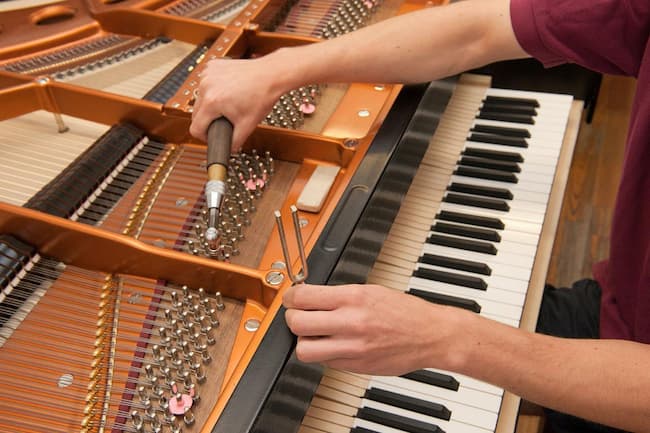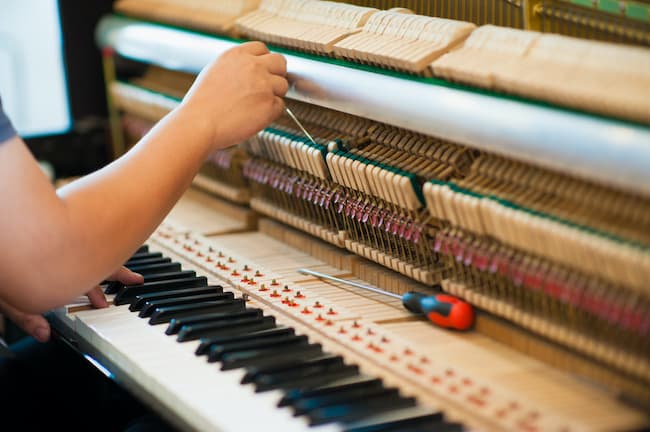If you don’t know how to tune a piano and are in search of an easy guide that teaches you piano tuning, then you came to the right place. The piano, an instrument of rich tonal quality and wide dynamic range, is a cornerstone of many musical genres. However, to ensure its harmonious output, regular tuning is essential.

This article will guide you through the process of how to tune a piano, ensuring your instrument stays in key and continues to produce beautiful melodies. Whether you’re a seasoned pianist or a beginner, these simple steps, coupled with a little patience and practice, will help you master the art of piano tuning.
What is Piano Tuning?
A piano’s pitch can go out of tune due to various factors like humidity, temperature changes, or even just simply playing it frequently. Piano tuning is the process of adjusting the instrument so that its notes are at the correct pitch. This is done by tightening and loosening its strings to bring them into a state of harmony.

Piano tuning is a necessary part of piano maintenance, as the instrument’s strings tend to gradually go out of tune over time. It also helps to maintain the instrument’s beautiful sound and overall performance.
Tools Required To Tune a Piano
Before you can start to learn how to tune a piano, it’s important to have the right tools for the job. Here are some of the items you’ll need:
- Tuning lever: A tuning lever, or wrench, is used to adjust the tension of the strings. It’s best to use a professional-grade tuning lever for accurate results.
- Electronic tuner: An electronic tuner can help you tune your piano more precisely by providing an audible tone when each note is reached.
- Mute rail: A mute rail is an optional tool that can be used to dampen the piano’s strings while you tune, making the process less noisy and more efficient.
- Screwdriver: A screwdriver is used to adjust the tuning pins, which hold the strings in place.
- Piano tuning hammer: This specialized tool helps you apply precise pressure when tightening or loosening the strings.
- Flashlight: A flashlight is necessary for tuning in dark areas of the piano, like its interior or underneath the keyboard.
- A dustcloth: A dustcloth will help you keep your piano clean while you work.
How To Tune a Piano: Steps for Piano Tuning
If you are a beginner and don’t know how to tune a piano, it is best to get a professional piano tuner to tune your instrument. However, with practice and patience, tuning a piano yourself can become a rewarding experience. There are 7 steps you need to follow for how to tune a piano.

Set up the Space
Before you start tuning your piano, make sure the area around it is properly set up. The floor should be even and free from debris. Place a soft cloth or rug underneath the instrument to protect its surface and reduce noise.
You must also ensure there are no appliances or fans nearby that could interfere with the tuning process. Any object that can make a humming or buzzing sound can affect the instrument’s pitch.
Prep Middle C Strings
Start with identifying and prepping the Middle C strings. These are usually grouped together in the center of the piano, making them easy to find.
First, use a flashlight to locate the tuning pins for each note. Once you’ve found them, loosen their grip with a screwdriver. Then, use your tuning lever to adjust each string’s tension until they reach the middle C pitch.
Tune the Octaves
Once you’ve completed tuning the Middle C strings, the next step is to tune the octaves. This means adjusting all of the strings connected to each C note on the keyboard until they reach a harmonic frequency.
For this step, you will need your tuning lever and electronic tuner. Carefully move from one end of the piano’s range to the other, tightening or loosening the strings as necessary. Use the electronic tuner to ensure each note is correctly tuned before moving on to the next one.
Tune Note by Note
Once you have tuned all of the octaves, it’s time to go through and tune each note individually. Move your tuning lever across the strings connected to each note, listening for any discrepancies in pitch. Your electronic tuner will come in handy here as well.

Again, it is important to be patient and take your time with this step; you need to make sure all of the notes are perfectly in tune before moving on.
Accurate Tuning
When tuning the strings of a piano, it’s important to pay attention to the intervals between octaves and notes. This means you need to adjust the strings until each note is in harmony with the one above and below it.
For this, you will need your tuning hammer. Use light taps to apply precise pressure on the strings, adjusting their tension as needed. It’s also helpful to use a mute rail during this process; it will dampen the strings and make it easier to hear the differences in pitch.
Listen to Your Work
Once you have finished tuning all of the notes on your piano, take a moment to listen to your work. This can help you identify any issues or discrepancies in pitch that may have gone unnoticed during the process.
If you find any problems, go back and adjust the strings until everything is in tune. Don’t worry if it takes several attempts; tuning a piano correctly requires patience and practice.
Once you are satisfied with the sound of your instrument, it’s time for the final touches. Carefully replace all of the screws that hold the tuning pins, ensuring they are tightly secured. When you’re done, give the entire piano a good dusting and make sure it looks as polished as its sound. That’s it. You have learned how to tune a piano.
More Similar Articles To Look:
- Difference between acoustic and digital piano
- how to become a concert pianist
- What is the best piano brand
- How to play faster on piano
Conclusion
There it is! After all of your hard work, you now have an instrument that sounds beautiful and performs well. Sit down at the keys and bask in the sweet melodies your tuning has created – then put that newfound knowledge to use and start tuning your own piano! We hope this article helped you understand how to tune a piano successfully. Visit Pianos Hub if you want to learn more details and see piano-related guides